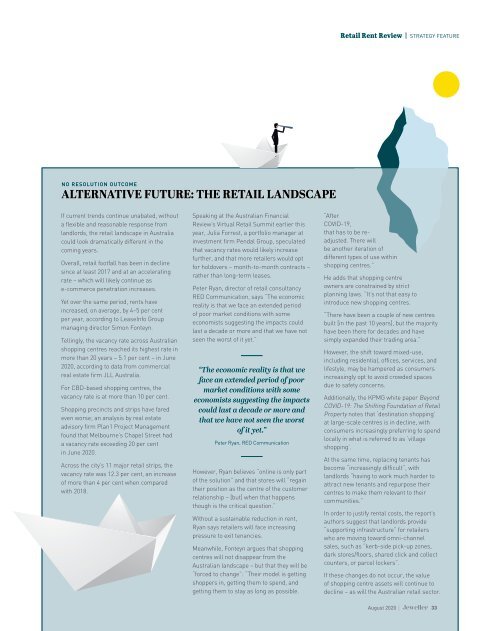Jeweller - August 2020
• Tech’s appeal: Understanding your customers’ e-commerce expectations • Balance of power: Review of retail leases and negotiation in the post-covid environment • Market update: new and bestselling products from leading suppliers
• Tech’s appeal: Understanding your customers’ e-commerce expectations
• Balance of power: Review of retail leases and negotiation in the post-covid environment
• Market update: new and bestselling products from leading suppliers
Create successful ePaper yourself
Turn your PDF publications into a flip-book with our unique Google optimized e-Paper software.
Retail Rent Review | STRATEGY FEATURE<br />
NO RESOLUTION OUTCOME<br />
ALTERNATIVE FUTURE: THE RETAIL LANDSCAPE<br />
If current trends continue unabated, without<br />
a flexible and reasonable response from<br />
landlords, the retail landscape in Australia<br />
could look dramatically different in the<br />
coming years.<br />
Overall, retail footfall has been in decline<br />
since at least 2017 and at an accelerating<br />
rate – which will likely continue as<br />
e-commerce penetration increases.<br />
Yet over the same period, rents have<br />
increased, on average, by 4–5 per cent<br />
per year, according to LeaseInfo Group<br />
managing director Simon Fonteyn.<br />
Tellingly, the vacancy rate across Australian<br />
shopping centres reached its highest rate in<br />
more than 20 years – 5.1 per cent – in June<br />
<strong>2020</strong>, according to data from commercial<br />
real estate firm JLL Australia.<br />
For CBD-based shopping centres, the<br />
vacancy rate is at more than 10 per cent.<br />
Shopping precincts and strips have fared<br />
even worse; an analysis by real estate<br />
advisory firm Plan1 Project Management<br />
found that Melbourne’s Chapel Street had<br />
a vacancy rate exceeding 20 per cent<br />
in June <strong>2020</strong>.<br />
Across the city’s 11 major retail strips, the<br />
vacancy rate was 12.3 per cent, an increase<br />
of more than 4 per cent when compared<br />
with 2018.<br />
Speaking at the Australian Financial<br />
Review’s Virtual Retail Summit earlier this<br />
year, Julia Forrest, a portfolio manager at<br />
investment firm Pendal Group, speculated<br />
that vacancy rates would likely increase<br />
further, and that more retailers would opt<br />
for holdovers – month-to-month contracts –<br />
rather than long-term leases.<br />
Peter Ryan, director of retail consultancy<br />
RED Communication, says “The economic<br />
reality is that we face an extended period<br />
of poor market conditions with some<br />
economists suggesting the impacts could<br />
last a decade or more and that we have not<br />
seen the worst of it yet.”<br />
“The economic reality is that we<br />
face an extended period of poor<br />
market conditions with some<br />
economists suggesting the impacts<br />
could last a decade or more and<br />
that we have not seen the worst<br />
of it yet.”<br />
Peter Ryan, RED Communication<br />
However, Ryan believes “online is only part<br />
of the solution” and that stores will “regain<br />
their position as the centre of the customer<br />
relationship – [but] when that happens<br />
though is the critical question.”<br />
Without a sustainable reduction in rent,<br />
Ryan says retailers will face increasing<br />
pressure to exit tenancies.<br />
Meanwhile, Fonteyn argues that shopping<br />
centres will not disappear from the<br />
Australian landscape – but that they will be<br />
“forced to change”: “Their model is getting<br />
shoppers in, getting them to spend, and<br />
getting them to stay as long as possible.<br />
“After<br />
COVID-19,<br />
that has to be readjusted.<br />
There will<br />
be another iteration of<br />
different types of use within<br />
shopping centres.”<br />
He adds that shopping centre<br />
owners are constrained by strict<br />
planning laws. “It’s not that easy to<br />
introduce new shopping centres.<br />
“There have been a couple of new centres<br />
built [in the past 10 years], but the majority<br />
have been there for decades and have<br />
simply expanded their trading area.”<br />
However, the shift toward mixed-use,<br />
including residential, offices, services, and<br />
lifestyle, may be hampered as consumers<br />
increasingly opt to avoid crowded spaces<br />
due to safety concerns.<br />
Additionally, the KPMG white paper Beyond<br />
COVID-19: The Shifting Foundation of Retail<br />
Property notes that ‘destination shopping’<br />
at large-scale centres is in decline, with<br />
consumers increasingly preferring to spend<br />
locally in what is referred to as ‘village<br />
shopping’.<br />
At the same time, replacing tenants has<br />
become “increasingly difficult”, with<br />
landlords “having to work much harder to<br />
attract new tenants and repurpose their<br />
centres to make them relevant to their<br />
communities.”<br />
In order to justify rental costs, the report’s<br />
authors suggest that landlords provide<br />
“supporting infrastructure” for retailers<br />
who are moving toward omni-channel<br />
sales, such as “kerb-side pick-up zones,<br />
dark stores/floors, shared click and collect<br />
counters, or parcel lockers”.<br />
If these changes do not occur, the value<br />
of shopping centre assets will continue to<br />
decline – as will the Australian retail sector.<br />
<strong>August</strong> <strong>2020</strong> | 33


















